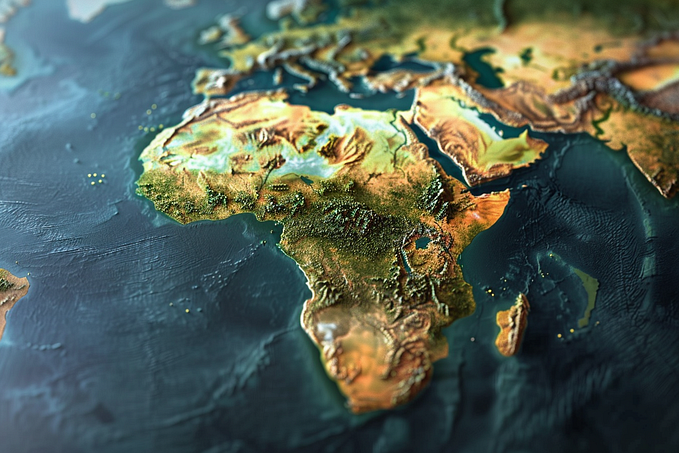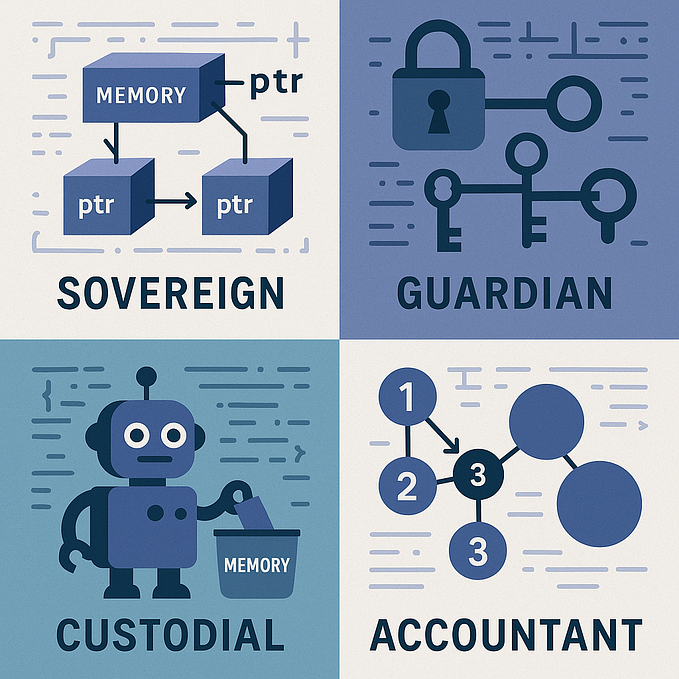If Social Democracy Is So Great, Why Is the US Richer Than Nordics?
A look at the reasons for the higher American GDP per capita

WHEN preaching the virtues of social democracy, there is always some libertarian or neoliberal who will champion the virtues of capitalism by pointing out the fact that on average Nordic countries have lower GDP per capita than the US. In fact, people of Nordic descent make more money on average in the US than in Nordic countries.
A number of people have taken the title and this introduction as me being an advocate of American capitalism and critique of Nordic social democracy. So let me be clear about that: I am a Norwegian social democrat myself, and written extensively about the virtues of the Nordic model:
The title of this story is from a popular question I saw online which aimed to challenge the idea that Nordic social democracy is a success. This story is written as a rebuttal.
Social Democracy really got started after WW2 in the Nordics. So if social democracy was bad for the economy compared to American capitalism, you would see Nordic economies growing slower than the American economy. Except if you look at relative growth from 1950 to 2018 that is not the case. In that time period the US economy grows 269% while Finnish and Icelandic economies both grow over 400%.
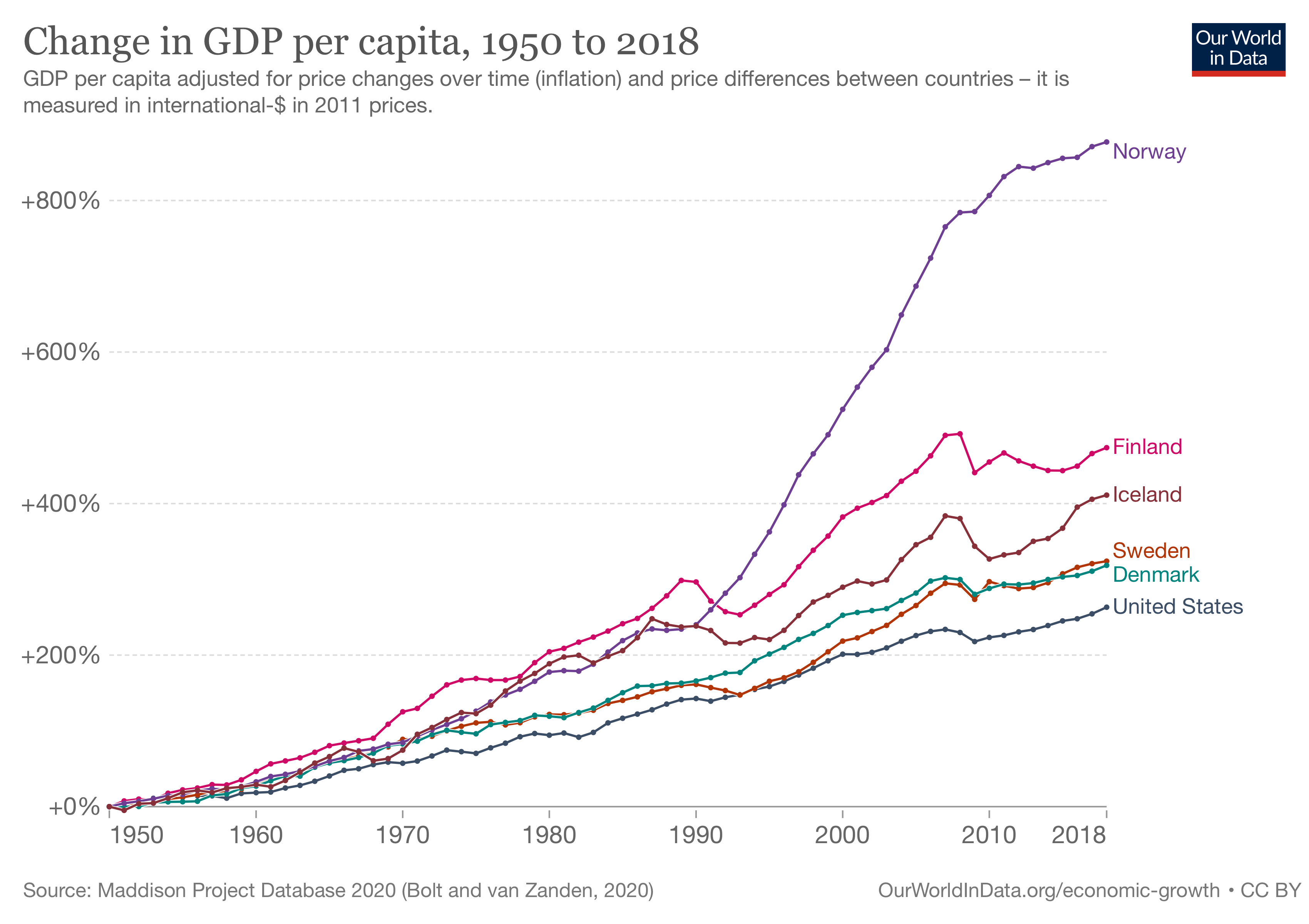
This is a point I have often made, but my neoliberal Twitter friend-foe Mark will always point as this is to be expected because Nordic countries started at a lower base. And Mark is absolutely right. Poorer countries tend to have stronger growth because of the so-called catchup effect. That is part of the reason China had insane double-digit growth for many years.
So, the question then is: Why does the US start at a higher base and how much richer was the US in 1950 exactly?

As you can see, the difference was substantial. US GDP per capita was nearly 80% higher than the GDP per capita of my native Norway, and a staggering 230% higher than Finland. In 2018, you can see that picture change a lot. The American advantage over Finland has been narrowed down to 40% since Finland has grown rapidly. My native Norway has, of course, surpassed the US, but that may be less interesting to compare since Norway is a big oil exporter.

Hence, to understand why the US is so much richer than most Nordic countries we have to dig deeper into history. The US has simply had a massive head start and despite growing faster, it takes time to catch up. Did the US grow much faster than the Nordic countries before WW2? No, in fact from 1900 to 1950 the Nordic countries still outperformed the US in growth.
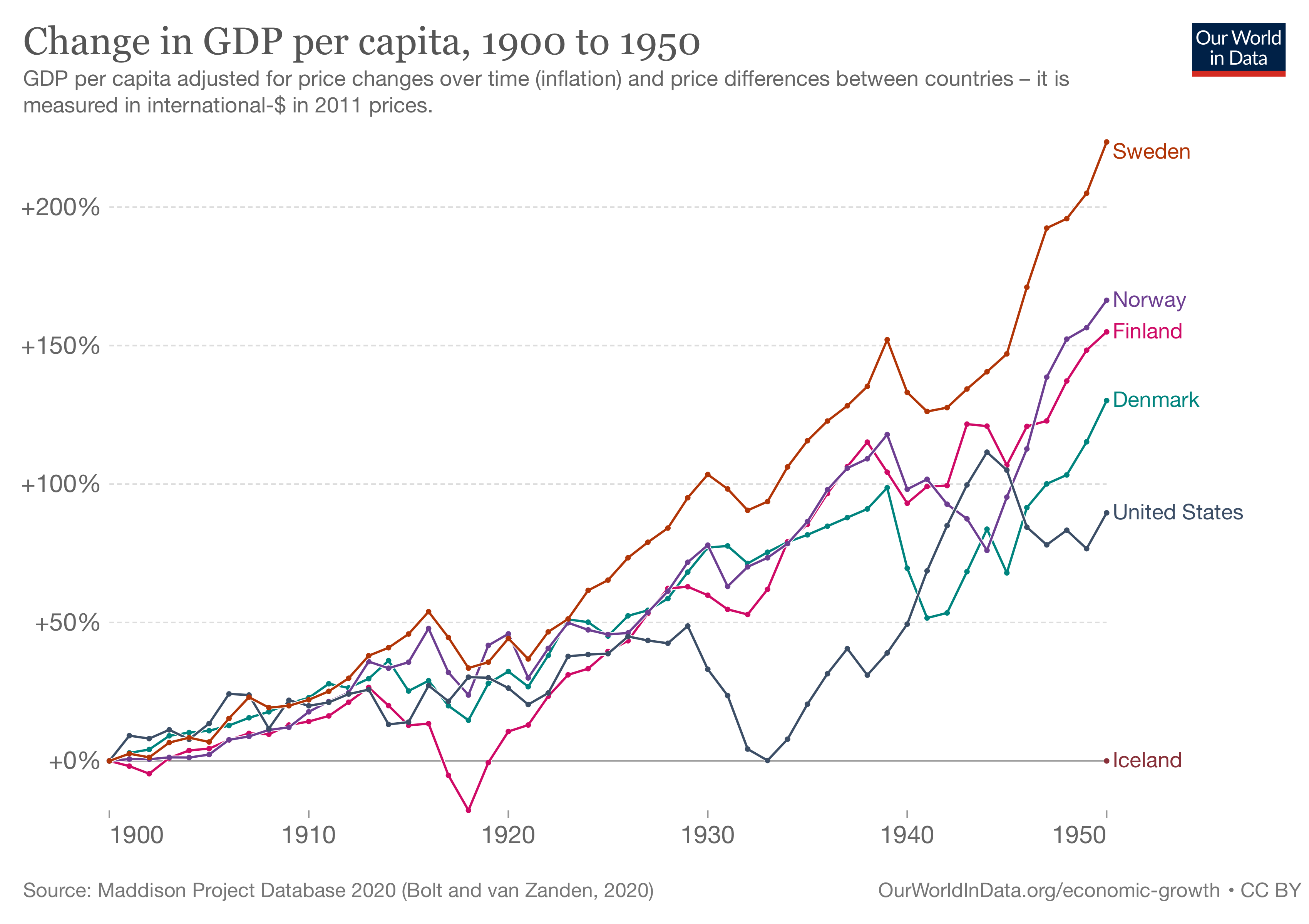
Thus, the American advantage actually began much earlier. In fact, it goes so far back we cannot get good data for it. We don’t have good data to derive GDP until around 1800. You can see the US grew strong in the period 1800 to 1900, but already in 1800 in started out much richer than any Nordic country.
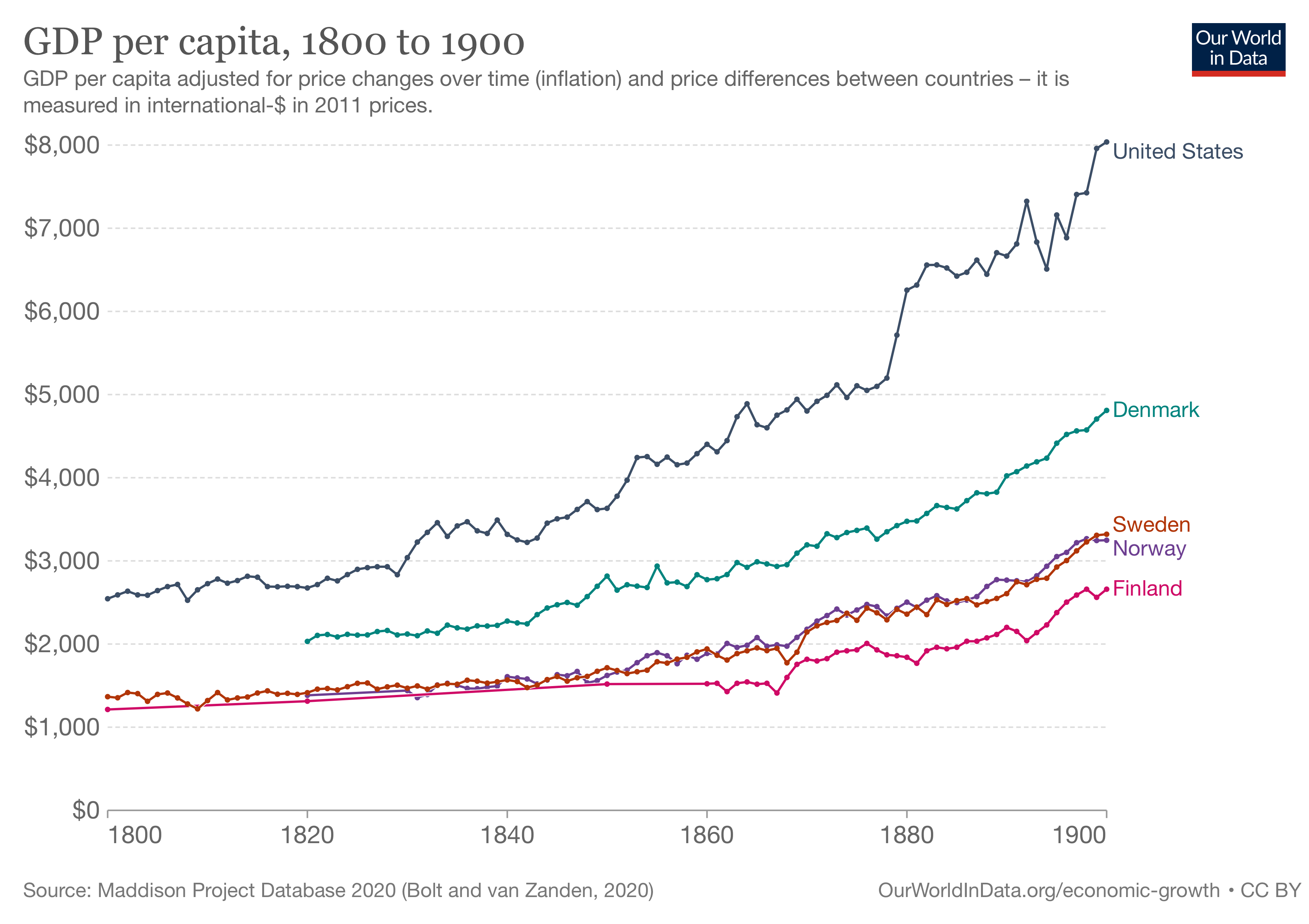
We can pick a year when we have a decent amount of data, such as 1820. That is shortly after Norway has become an autonomous country in a union with Sweden. At this point, American GDP per capita is about 190% higher than that of Norway. The US is about twice as rich as Norway.
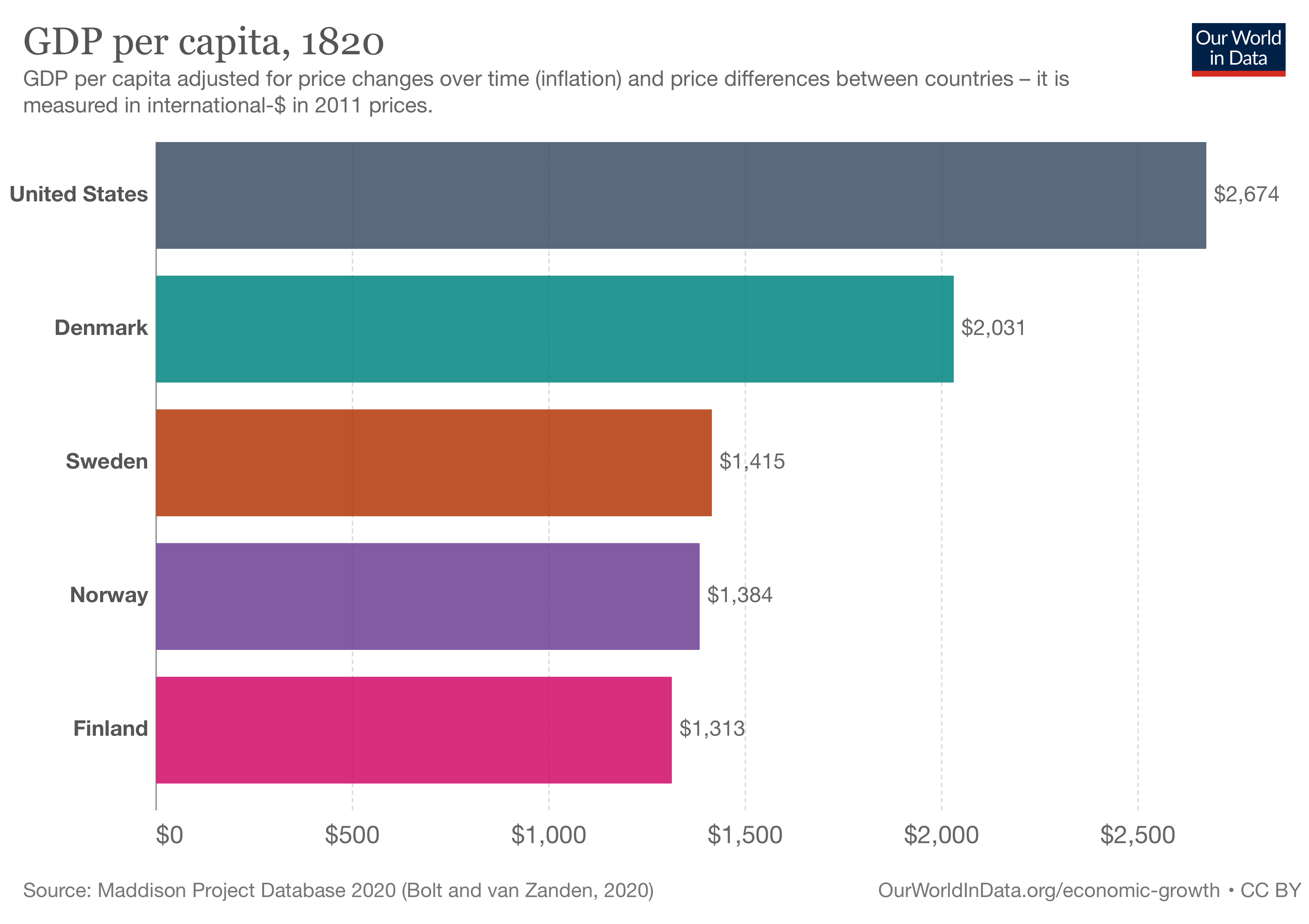
Let me give you a sense of just how large this difference is. Countries with half the GDP per capita of the US today are countries like the Bahamas and Panama. That was the relative difference between the US and Nordic countries like Norway and Finland.
So blaming socialism, social democracy or not enough capitalism doesn’t really cut it. Neither socialism nor social democracy played any role in Nordic countries until the 1920s. The US was far ahead long before that. One cannot blame a big government and high taxes because Nordic countries actually tended to have lower taxes than the US. Nordic tax rates did not start to go higher than the US until the 1960s.
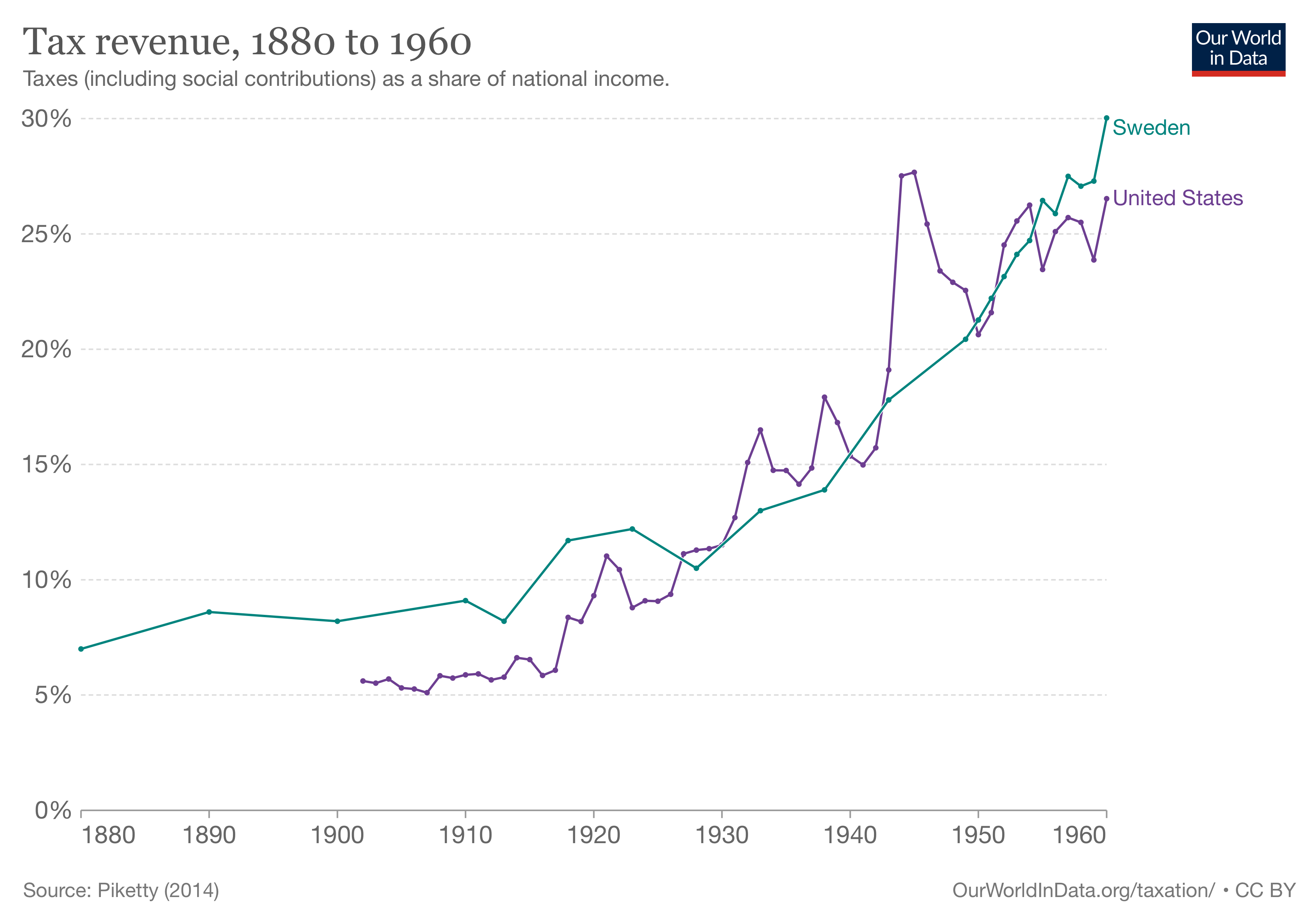
So, where did the massive economic difference come from, which was present already in 1800? Were the Americans just so much smarter at industrializing, building factories and industries? Hardly as the American industrial revolution began in 1790, and the US was already way ahead at that time. Looking at which Nordic country was the richest actually gives a little hint.
The Importance of Agriculture for the Economy
Today when people think about valuable resources they think of oil, coal, iron, gold and silver, but before industrialization these were not really the resources that mattered. What mattered more than anything else in any economy was agriculture. In fact, many contemporary analysts are always puzzled by the preoccupation of what many see as the father of capitalism, Adam Smith, with agriculture in his great work, “the Wealth of Nations”, published in 1776. Why was he not more concerned with steam engines and factories, which began around that time in Britain? Simply because the economic importance of manufacturing completely paled in comparison to the importance of agriculture to the economy.
Rich countries back then were countries with a lot of rich soil and well cultivated crops. That is why Denmark was so much richer than other Nordic countries. Denmark has no natural resources to speak of. No mines, forests, coal, or iron to speak of. However, around 70% of Denmark is arable, vs only 2.5% of Norway.
European colonialists were not primarily concerned with the US because of timber, gold, silver, or anything like that. They came to grow tobacco, cotton, grain, and other agricultural products. It was the vast, rich American soil which attracted them. It was the agriculture which powered American growth, and a lot of that agriculture was powered by slavery. As pointed out by the Guilder Lehrman institute of American history, the main export of America was produced by slaves:
In the pre-Civil War United States, a stronger case can be made that slavery played a critical role in economic development. One crop, slave-grown cotton, provided over half of all US export earnings. By 1840, the South grew 60 percent of the world’s cotton and provided some 70 percent of the cotton consumed by the British textile industry. Thus slavery paid for a substantial share of the capital, iron, and manufactured goods that laid the basis for American economic growth.
Let us put that in context. Cotton was as big part of US export in the 1800s as oil is to Norwegian exports today. In other words, slaves were the American oil. Slaves were a considerable part of the American economy, especially in the South, which was until industrialization picked up the richest part of America. From NPR interview:
South Carolina and Georgia and some parts of North Carolina, it was almost a black majority of the population. Close to 50% of the population was enslaved Africans or African Americans.
For a country wanting to modernize and industrialize, exports are essential. That is how you get foreign currency to import machines and equipment. You needed cash to buy machines and raw materials from the British.
Edit: Not everyone agrees with me on the importance of slavery for economic development, so I wrote a specific article tackling this question in a lot more detail: Did Slavery Benefit the US Economy?
Why the Catchup-Effect Did Not Kick in For Nordics
Catchup-effect works when the economy is mainly manufacturing and services, as you can import ideas from countries ahead. But when economies are mainly agriculture and raw material based you cannot work wonders. You cannot import pieces of farmland from other countries. Nordic countries simply lacked the vast agricultural land accessible in North America.
The average farm in Norway at the time was just 20 acres. In the US with the homestead act they gave you farms of 320 acres for free. Not only that, but the soil was of much better quality. Norway, Finland, and Iceland all have rather poor soil and climate. Without incomes from a profitable agricultural sector one could not build up capital to finance factories and other industrial activity.
Denmark had more potential, but lacked raw materials such as coal and iron. It also lacked rivers to power water wheels. Until 1820 the industrial revolution in Britain was powered primarily by water wheel. The water wheels powered the bellows in the big smelters and the machines in the textile mills. In fact, none of the Nordics had coal and importing a bulk product like coal was not cheap. Hence, any factory setup in a Nordic country could not easily compete with the British.
The US, however, had coal, rivers, iron and plenty of capital from agricultural production and slavery to make an industrial revolution happen. Cotton could be shipped along the coast to the Northern states such as Massachusetts, with plenty of rushing streams to power water wheels driving cotton mills.
What Enabled the Nordic Catchup?
Thus, Nordics in the 1800s lacked many of the conditions which allowed the US to grow wealthy. There were no slave-driven cotton plantations in Finland or Iceland to give valuable exports. Denmark as we saw could better keep up because it had a stronger agricultural foundation, but it lacked most conditions to really industrialize. In fact, Denmark is a bit of an oddball in that it modernized and got rich in large part without really industrializing. It got ever more advanced agriculture and machine industry, but not huge factories with smoking chimneys.
Nordic countries had to pursue very different strategies from the US to grow. In Norway, agriculture was far too weak to power growth. Quite the contrary, Norway could not even feed itself but relied on massive imports. But to pay for imports, you need to actually have something to export. The primary export for Norway became timber. Farmers would use the winter months to cut trees and pull them down to streams, taking them down to the fjords where ships could pick them up and take them to Britain and the Netherlands. Norway also had strong maritime traditions since Viking times which meant Norway was also making money on shipping, but this was long limited because Norway go shut out of markets by the great powers. It was not until the British navigation acts ended in 1849 that Norway got a big boost in shipping. These were English laws which made it illegal for anyone but the British to ship goods to Britain.
Norway also had fish that helped. But you can see perhaps why Finland was so far behind for a long time. They were under Swedish and then Russian rule, while also not really having much of anything to make money off. Finland had more agricultural lands than Norway, but did not have the streams and fjords facilitating lumber exports. In Norway, waterfalls were used to power sawmills. Finland did not have that option, most places.
Because Nordic countries were capital poor they could not utilize a rich capitalist class like in the US and Britain to finance major infrastructure like railroad, telegraph, hydropower stations and later phone lines. Thus, relative poverty combined with a long tradition of high-quality government and early democracy laid the foundations for a collectivist modernization effort.
Central, government, municipalities, volunteers and private enterprise often worked together in joint projects to build railroad, telegraph lines, power stations and later phones lines. They had to pull together to make these things happen, as none had the resources alone to do it. Thus, social democracy which came much later has roots in a much earlier spirit of cooperation.
Summary
- The economic advantage the US enjoys over Nordic countries today got established when agriculture and slavery powered the US economy
- Nordic countries lacked agricultural land and climate to compete with the US in agricultural output, especially in cash crops like cotton and tobacco which gave large export incomes
- Agricultural exports are what historically has provided capital to invest in industrialization. Without profits from agriculture, industrialization will be delayed.
- Foreign investment is a possibility, but Nordics lacked coal and large population centers and markets to make investing in industrialization attractive for foreigners
- Development of electric motors and turbines allowed Nordic countries to circumvent the limitations imposed by lack of access to cheap coal
- Ever since Nordic countries got the opportunity to industrialize, they have grown faster than the US economy
Related Articles
If you are interested in this topic, I have written a number of other articles covering related topics from a Nordic perspective (I am Norwegian).
- How Climate and Geography Shaped Scandinavian Prosperity and Democracy — Comparing with old civilizations like Egypt, Sumer, Persia and Greece on how climate and geography affect development. Specifically looking at things like water systems, irrigation, dams, fjords and canals.
- Is Scandinavia Better to Live in Than the USA? — A comparison of what life is like for a middle class family in Scandinavia and the US. What are the pros and cons? A look at neighborhoods, work life, material wealth and lifestyle
- Nordic Welfare Spending, Cuts and GDP Growth — This story came about because I kept hearing from so many American the belief that socialist policies had destroyed Nordic economies and they had to abandon them. This story is busting that myth, show it was in fact liberalization which crashed the economies in the Nordics in the late 1980s.
- How Norway Got Rich Against All Odds Before Oil — A detailed economic history of Norway from 1800 to 1940s, explaining how a country with poor conditions for prosperity managed to get rich anyway long before oil was discovered in the North Sea.

